
You might associate VFX primarily with 3D visual effects like explosions, fire, smoke, or tornadoes. Still, there are numerous cases where 2D VFX is skillfully integrated to create iconic and visually striking shows, such as Arcane and Riot Games cinematics.
In the constantly evolving world of digital animation, creators are always looking for ways to enhance quality, save time, and create breathtaking visuals. One such advancement is the increasingly integrated use of 2D VFX in 3D animation. While the two have historically been considered separate styles, today’s modern tools and hybrid workflows have brought these disciplines together, enabling artists to combine the best of both worlds.
This guide explores how 2D VFX helps create perfect 3D animations more efficiently and effectively in 2025, spotlighting current techniques, tools, and workflows that have revolutionized the animation landscape.
Understanding the Basics: 2D VFX vs. 3D Animation: Key Differences
To understand the value of combining these techniques, it’s important to define the two components:
- 2D VFX (Visual Effects) refers to effects created in two dimensions, such as smoke, fire, light flares, hand-drawn motion lines, and other stylized overlays.
- 3D Animation, on the other hand, involves animating characters and environments in a three-dimensional space, offering realistic depth, perspective, and movement.
The key difference lies in dimension and complexity. 2D VFX is more stylistic, often used to enhance a scene with graphic flair. 3D animation focuses on realism, perspective, and dynamic camera movement. In 2025, combining these two brings visual richness and efficiency to projects of all sizes.
Why Blend 2D VFX with 3D Animation?
Blending 2D effects with 3D environments is no longer just a stylistic choice—it’s a strategic one. Here’s why this hybrid approach is gaining momentum:
1. Creative Freedom
2D VFX offers stylized motion graphics, visual flourishes, and abstract designs that 3D tools often struggle to replicate efficiently. This opens up more creative avenues without the technical burden of complex simulations.
2. Efficiency in Production
Rather than spending time rendering intricate 3D particle systems, 2D overlays can be used to simulate effects such as smoke, water splashes, or magic glows. These can be animated much faster and composited seamlessly into a 3D scene.
3. Improved Rendering Speed
Rendering full 3D simulations takes time and computing power. By replacing or enhancing some of these with 2D VFX techniques, production teams can reduce render times while maintaining high visual fidelity.
4. Hybrid Stylization
The mixed look of 2D and 3D has become increasingly popular in film, games, and advertising. This aesthetic adds a hand-crafted or comic-book vibe, making animations feel unique and engaging.
How to Integrate 2D VFX in 3D Animation
Successful integration starts with understanding workflows and planning during pre-production. Here’s a step-by-step approach:
Step 1: Pre-Visualization and Storyboarding
During the concept phase, animators decide where 2D effects would enhance storytelling. This can be noted directly in storyboards with visual annotations.
Step 2: Asset Separation
Keep 3D animation and 2D VFX assets on separate layers or passes for maximum flexibility. This allows compositors to adjust timing, effects, and interactions without affecting the core animation.
Step 3: VFX Planning and Style Matching
Consistency is crucial. If your 3D animation has realistic lighting, your 2D effects should match it in shading and timing. Conversely, for stylized looks, you may use frame-by-frame 2D animations for a more handcrafted feel.
Step 4: Compositing
In post-production, tools like Adobe After Effects or Nuke are used to blend 2D effects into 3D scenes. Motion tracking, masking, and blend modes help seamlessly merge the two worlds.
Enhancing 3D Animations with 2D VFX Techniques
Let’s dive into some practical ways that 2D VFX techniques can elevate your 3D scenes:
1. Lighting and Glow Effects
Adding 2D glows, light streaks, or magical auras as overlays saves time and adds polish. These elements often don’t require full 3D rendering and are easier to control.
2. Atmospheric Elements
Dust particles, smoke trails, and raindrops are commonly added as 2D effects, especially when subtle and layered. These improve mood and realism without overburdening the render engine.
3. Action Lines and Motion Smears
2D motion lines enhance impact in action scenes, particularly in stylized animations. They’re widely used in anime-inspired 3D works to dramatize movement.
4. Simulating Destruction
Explosions and debris fields are often layered as 2D sequences. While 3D physics engines can do the job, they can be heavy to simulate. 2D VFX can mimic these effects convincingly.
5. Spell or Energy Effects
Fantasy and sci-fi scenes benefit greatly from hand-animated 2D magic or energy blasts. These add flair and visual storytelling depth.
How 2D Effects Improve 3D Rendering Quality
In 2025, rendering pipelines are more efficient than ever, but certain effects still bog down even the best systems. 2D effects can greatly reduce render loads by serving as placeholders or stylized elements that mimic complex simulations.
Here’s how:
- Post-render overlays let teams tweak effects in real-time without re-rendering the whole scene.
- Masking and matte painting using 2D elements reduce the need to model complex backgrounds.
- Reuse of 2D effects is easier across different shots, cutting production time.
The result is faster, cleaner, and more visually diverse animation that still meets the highest production standards.
Best Practices for Efficient Integration
To ensure smooth implementation of 2D effects in a 3D pipeline, consider the following best practices:
– Plan Early: Involve VFX artists during storyboarding and layout stages.
– Use Layered Workflows: Work in passes and separate your 3D renders from 2D assets.
– Maintain Resolution Independence: Use vector-based or high-res 2D effects to maintain visual fidelity.
– Utilize Blend Modes: Master blend modes in your compositor to layer effects naturally.
– Keep Color Grading in Mind: Apply effects after color grading, or match the color tone during design.
Best Software for 2D and 3D Animation Effects
There are plenty of tools available for professionals and indie creators alike. Here are the most recommended in 2025:
For 2D VFX:
- Adobe After Effects – Still the industry standard for compositing and motion graphics.
- Toon Boom Harmony – Popular for hand-drawn FX, especially in TV and game cutscenes.
- Krita – Open-source alternative great for traditional 2D VFX creation.
For 3D Animation:
- Blender – Free and powerful with Grease Pencil integration for 2D-3D hybrid effects.
- Autodesk Maya – A staple for studios with high-end capabilities and FX plugins.
- Cinema 4D – Favored for motion graphics and procedural 3D animations.
For Compositing and Integration:
- Nuke – Preferred by high-end studios for its powerful compositing node system.
- Fusion (DaVinci Resolve) – Strong alternative with real-time node-based compositing.
Top 2D VFX Tools for Professional Animators in 2025
Professional animators working on hybrid projects benefit from a set of tools built specifically for FX. Here are top tools in 2025:
- EmberGen – Real-time volumetric simulations exported as 2D sprite sheets.
- Particle Illusion (part of Boris FX suite) – Great for fire, explosions, and magic.
- Grease Pencil in Blender – Best for drawing 2D effects directly in a 3D environment.
These tools allow animators to visualize effects quickly, iterate easily, and deliver high-impact visuals without massive budgets.
Examples of Real-World Applications
Many top studios now use hybrid workflows to maximize efficiency. Consider these examples:
– Spider-Man: Into the Spider-Verse
This film combined 3D models with 2D overlays for comic book-style effects. Action lines, halftones, and 2D explosions added dynamic energy.
– Arcane (Netflix)
Blends 2D painted textures and VFX with 3D characters to achieve a painterly, emotional effect.
– Valorant (Riot Games)
Cutscenes feature 3D characters enhanced with 2D particle effects for explosions and spell FX.
These demonstrate how 2D VFX and 3D animation are no longer separate—they’re symbiotic.
The Future of Hybrid Animation Pipelines
Looking ahead, the integration of 2D and 3D will only deepen. AI-assisted tools are beginning to automate repetitive 2D FX sequences, freeing artists to focus on design. Meanwhile, game engines like Unreal Engine 5 are allowing real-time compositing of 2D and 3D elements.
With virtual production becoming the norm, real-time feedback loops mean VFX teams can iterate and refine on the fly. Expect:
- Automated 2D FX generation from motion tags.
- Real-time stylized rendering.
- More motion-graphic integrations within 3D scenes.
Final Thoughts
In 2025, using 2D VFX to enhance 3D animation is no longer an afterthought—it’s a necessity for streamlined production, creative flexibility, and achieving eye-catching results. By blending the simplicity and stylistic power of 2D with the depth and realism of 3D, artists can craft unforgettable animations across games, films, marketing, and more.
Whether you’re an indie creator or a studio veteran, learning how to merge these worlds using the best software for 2D and 3D animation effects will set your work apart. Explore hybrid workflows, experiment with overlays, and elevate your animation pipeline for the future.
Frequently Asked Questions (FAQ’s)
What are 2D VFX, and how do they differ from 3D VFX?
2D VFX (two-dimensional visual effects) are visual effects created on a flat, two-dimensional plane. They typically involve hand-drawn elements or digital paintings that add stylistic and organic touches to animations. In contrast, 3D VFX (three-dimensional visual effects) are created in a 3D space, involving elements like textures, lighting, and simulations that interact within a three-dimensional environment.
Why are 2D VFX used in 3D animations?
2D VFX is used in 3D animations to add a unique, hand-created quality that complements and enhances the 3D elements. They can introduce textures, magical effects, or atmospheric details that might be difficult to achieve with 3D techniques alone. This combination creates a richer, more visually engaging experience.
What are some common techniques used in 2D VFX?
Common 2D VFX techniques include:
- Digital Painting: Creating frame-by-frame effects using graphics tablets and software like Photoshop.
- Cel Animation: Traditional frame-by-frame animation with hand-drawn elements.
- Particle Systems: Generating and animating small graphical objects to create effects like smoke or sparks.
- Rotoscoping: Tracing over live-action footage to integrate animated elements with real environments.
How do digital painting and cel animation contribute to 2D VFX?
Digital Painting allows artists to create detailed and stylistic effects like textures, lighting, and magical elements using software tools. This technique provides a hand-painted appearance that enhances the visual appeal of animations.
Cel Animation involves drawing each frame by hand, which adds a handcrafted, fluid quality to effects like water, smoke, and fire. This traditional technique contributes a unique texture and nuance that complements 3D elements.
Can you give examples of animations that effectively use 2D VFX?
Yes, two prominent examples are:
- “Arcane”: This Netflix series blends 2D artistry with 3D animation, using hand-drawn effects and matte paintings to create a visually striking adaptation of the “League of Legends” universe.
- “Spider-Man: Into the Spider-Verse”: This film incorporates comic book aesthetics into CGI, using halftone filters and speech bubbles to merge 2D art with 3D animation, creating a visually innovative experience.





